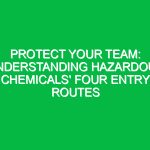Introduction
Demolition is a crucial process in construction and urban development, involving the dismantling or destruction of buildings and structures. Within the Health, Safety, and Environment (HSE) domain, understanding the term “demolition” is essential for ensuring the safety of workers, the public, and the environment. As we delve deeper into the topic, we’ll explore what demolition entails, the risks associated with it, and the best practices to ensure HSE success. This article aims to provide a comprehensive guide to the essential safety tips associated with demolition, ensuring that all stakeholders are well-informed and prepared for the challenges that this critical process presents.
Defining Demolition in the HSE Context
When we talk about “demolish define,” we are referring to the systematic process of tearing down structures. This can include everything from small residential buildings to large commercial complexes. In the HSE context, demolition is not merely about destruction; it encompasses a series of planned operations designed to minimize risks and ensure compliance with safety standards. Key aspects of demolition include:
- Planning and Preparation: Effective demolition begins long before the first wall is knocked down. It involves thorough planning, risk assessment, and resource management.
- Hazard Identification: Recognizing potential hazards, such as structural instability, falling debris, and exposure to hazardous materials, is crucial in the demolition process.
- Compliance with Regulations: Demolition activities must adhere to local, national, and international regulations designed to protect workers and the environment.
- Waste Management: Proper disposal and recycling of materials are essential components of environmentally responsible demolition.
Understanding these elements sets the foundation for a safer demolition process, reducing accidents and enhancing overall efficiency.
Key Aspects of Demolition in HSE
Planning and Risk Assessment
Before any demolition work begins, a comprehensive plan must be developed. This plan should include a detailed risk assessment that identifies potential dangers and outlines strategies to mitigate them. Effective planning involves:
- Site Survey: Conducting thorough inspections to identify structural weaknesses, hazardous materials, and adjacent properties that may be affected.
- Method Statement: Creating a method statement that details how the demolition will be conducted, including the sequence of operations, equipment to be used, and safety measures in place.
- Emergency Procedures: Establishing protocols for emergency situations, including evacuation plans and communication strategies.
A well-structured plan not only enhances safety but also ensures that the demolition project runs smoothly and efficiently.
Identification of Hazards
Recognizing hazards is a fundamental aspect of HSE in demolition. Common hazards include:
- Structural Collapse: Buildings may be unstable and prone to collapse during demolition, posing serious risks to workers.
- Hazardous Materials: Older buildings may contain asbestos, lead, or other toxic substances that require special handling and disposal.
- Noise and Vibration: Demolition activities can generate significant noise and vibration, impacting nearby residents and businesses.
- Falls and Falling Objects: Workers are at risk of falls from heights and being struck by falling debris.
A thorough hazard analysis allows for the implementation of appropriate control measures, ensuring a safer working environment.
Compliance with Regulations
Demolition activities are governed by a myriad of regulations aimed at protecting the workforce and the environment. Some of the key regulations include:
- Occupational Safety and Health Administration (OSHA): In the United States, OSHA sets standards for safety practices during demolition, including worker training and safety equipment requirements.
- Environmental Protection Agency (EPA): The EPA regulates the disposal of hazardous materials and the environmental impact of demolition projects.
- Local Building Codes: Many municipalities have specific regulations regarding demolition, including notification requirements and permits.
Familiarity with these regulations is essential for compliance and to avoid potential penalties.
Best Practices for Safe Demolition
Implementing best practices during demolition is critical for ensuring HSE success. Here are some actionable tips:
1. Conduct Comprehensive Training
All workers involved in demolition should undergo safety training tailored to the specific risks associated with their tasks. Training should cover:
- Proper use of personal protective equipment (PPE)
- Safe operation of demolition equipment
- Emergency response protocols
Regular refresher courses can help keep safety procedures fresh in workers’ minds.
2. Use Appropriate Personal Protective Equipment (PPE)
Workers must be equipped with the necessary PPE to protect against specific hazards. Common PPE includes:
- Hard hats to protect against head injuries
- Safety glasses or goggles to shield eyes from debris
- Gloves to protect hands from sharp objects
- High-visibility clothing to ensure workers are seen
Ensuring that all workers wear their PPE consistently can significantly reduce the risk of injury.
3. Implement Effective Communication
Clear communication is vital in demolition projects. Establishing channels for reporting hazards, sharing updates, and coordinating between teams can prevent accidents. Regular safety meetings should be held to discuss ongoing risks and reinforce safety protocols.
4. Adopt Environmentally Responsible Practices
Sustainable demolition practices not only protect the environment but can also reduce costs. Consider the following:
- Material Recycling: Salvaging materials like metals, bricks, and concrete for reuse can minimize waste.
- Green Demolition: Employing methods that reduce energy consumption and environmental impact.
Integrating environmentally friendly practices demonstrates a commitment to sustainability while enhancing public perception.
5. Monitor and Review Safety Procedures
Ongoing monitoring of safety practices is essential. Conduct regular audits and inspections to ensure compliance with safety protocols. Encourage feedback from workers to identify areas for improvement. This proactive approach fosters a culture of safety and continuous improvement.
Real-Life Examples of Successful Demolition Practices
To illustrate the importance of HSE in demolition, consider the case of a major urban redevelopment project in Chicago. The project involved the demolition of multiple aging buildings in a densely populated area. The demolition company conducted extensive planning and risk assessments, identifying potential hazards such as nearby traffic and the presence of hazardous materials.
They implemented a robust safety training program for all workers and established a clear communication protocol with local authorities. As a result, the project was completed ahead of schedule without any significant incidents, showcasing how effective planning and adherence to HSE principles can lead to successful outcomes.
Conclusion
In summary, understanding the concept of demolition within the HSE context is pivotal for ensuring the safety of workers and the environment. From meticulous planning and hazard identification to compliance with regulations and the implementation of best practices, every aspect plays a critical role in successful demolition projects. By prioritizing health, safety, and environmental sustainability, we can minimize risks and promote a safer work environment for everyone involved in the demolition process.
As the construction industry continues to evolve, it’s essential to emphasize the importance of HSE principles in demolition. We encourage all stakeholders—contractors, workers, and regulatory bodies—to remain vigilant and committed to implementing these essential safety tips. Together, we can ensure that demolition is not just about tearing down structures but also about building a safer, more sustainable future.


